Make sure you head to Slash’s official YouTube for loads of chat, fan questions, live cuts and more. For more features, click here.
Guitar Legends: Slash – the cat in the hat who saved hard rock guitar from itself
As he turns 55, it’s hats off to Guns N’ Roses’ Les Paul maestro Slash who’s been at the heart of hard rock for over 30 years. His guitar style is traditional but also unique, drawing on a wealth of soloing ideas and swaggering riffs. Here’s his essential gear and best tracks.
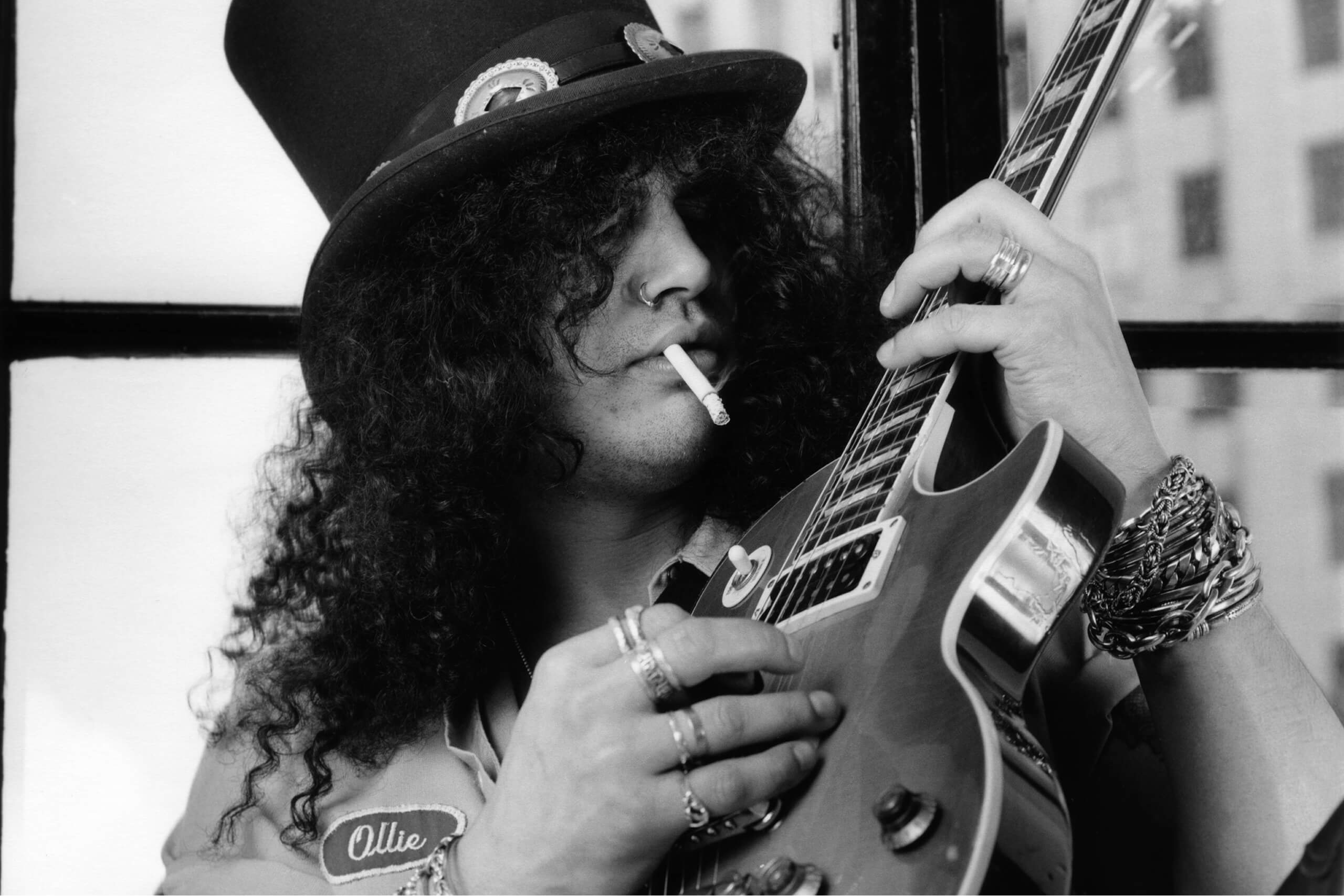
Image: Robert Knight Archive / Redferns
Death, taxes, Slash in a hat with a low-slung Les Paul… There are few things one can rely on in life, but Mr Saul Hudson is one the more immovable ones. As he turns 55, Slash remains remarkable. In the realm of hard rock, he just may be the most influential guitar player over the last five decades – the 80s, 90s, 2000s, the 2010s and now the 20s – and he has proved himself a true survivor. In 2012, Time named him the greatest guitarist ever… well, after Jimi Hendrix, but you already knew that.
Slash’s personal indulgences over the years would have killed most ordinary people. His band battles would have made most folk’s hair fall out. Yet, he keeps going, at 55. No more drugs, no more alcohol, he doesn’t even smoke anymore. In more recent years, he’s said he prefers listening to Adele and building Lego with his sons. But he still loves playing guitar like an absolute beast.
Guns N’Roses is a saga of its own, but Slash has also sailed choppy waters in his other projects – Slash’s Snakepit, Velvet Revolver in particular, and even his self-named ‘band’ of recent years where he’s juggled commitments adeptly and made it all work. His guest-recordings are numerous, from Alice Cooper to Michael Jackson to movie scores. You don’t call Slash, though, if you want a do-it-all sessioneer adept at any style. You call him if you want your songs “Slashing”. Why the Bee Gees needed that, only they know. Why Slash answered their call… only he knows! Slash once had the honour of being asked by producer Don Was to play on a Bob Dylan record: “Bob said it sounded a little bit too much like Guns N’ Roses. So he just took it off,” he laughs. He understands that.
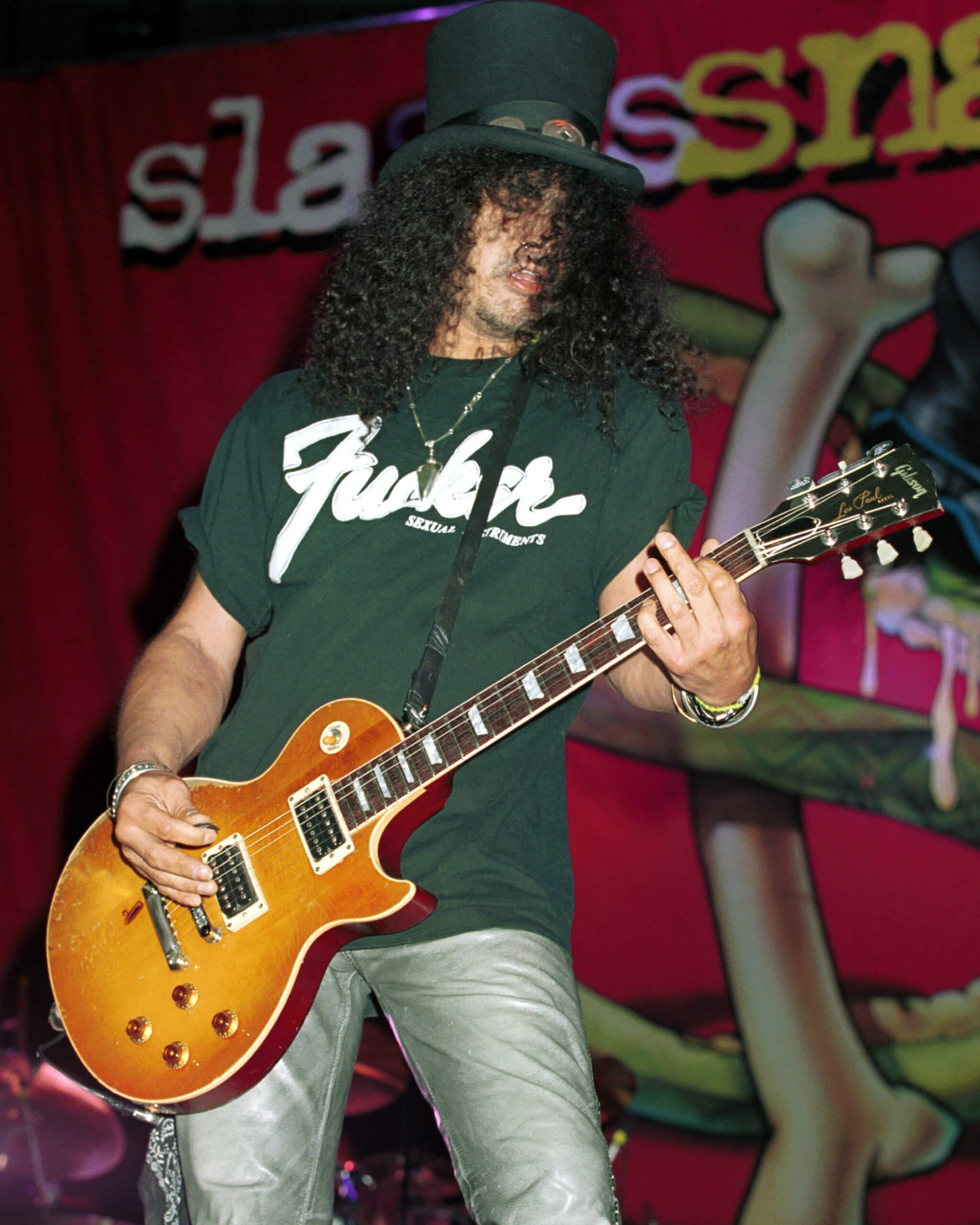
Despite his fame, he’s open and honest enough to realise this sort of approach made him the player he is. “I don’t practise,” he once said. “The way I learned was playing with other musicians that played 10 times better than me. The best thing for me is to go out and do a physical full-out rehearsal. That’s when the whole physical thing comes into it and you realize that 10 hours a day of practising doesn’t mean shit because the whole thing is completely different. I learned that a long time ago. No venue is the same, and playing in your bedroom is not the same as playing in front of people.”
So, if you want to be like Slash, his advice is pretty simple. Grab your guitar and get out there and play. A hat is optional.
Even so, to achieve what he has must take incredible patience. How he and Axl Rose can even work together, let alone nail their unique rock ’n’ roll chemistry, is a mystery. In a Q&A with The Guardian once, Slash was asked what his greatest fear was: He replied; “Not showing up. I never do that, but I fear the idea of doing it.”
Asked what trait he most deplored in others? “Being obnoxiously loud.” Tellingly, the trait he most deplores in himself was “Making excuses.” Who on earth could he mean?
Add all these up, and you have the mini-worldview of Slash. Don’t “practise” per se, just listen… do… persevere. Don’t be rude. Show up! Play. No excuses.
Slash in his own words
“I always would have ended up with a Les Paul. I was raised on David Gilmour just as much as Jimmy Page and as much as Jimi Hendrix. But the Les Paul, something about the combination of looks and sound… I just gravitated to the Les Paul without even thinking about it.”
“Buddy Guy is one of the best rock ’n’ roll blues guitar players there has ever been. I jammed with him a couple of times at his club in Chicago, and it was great. He was this huge, blistering lead guitar player… and there aren’t many of them left.”
“Jeff Beck, Blow By Blow, is a big one for me,” he says of his favourite ever records. “Hendrix Axis: Bold as Love, Disraeli Gears from Cream… I know these are all ancient records, but they’re just what I was sort of weaned on – Led Zeppelin II, and Aerosmith Rocks.”
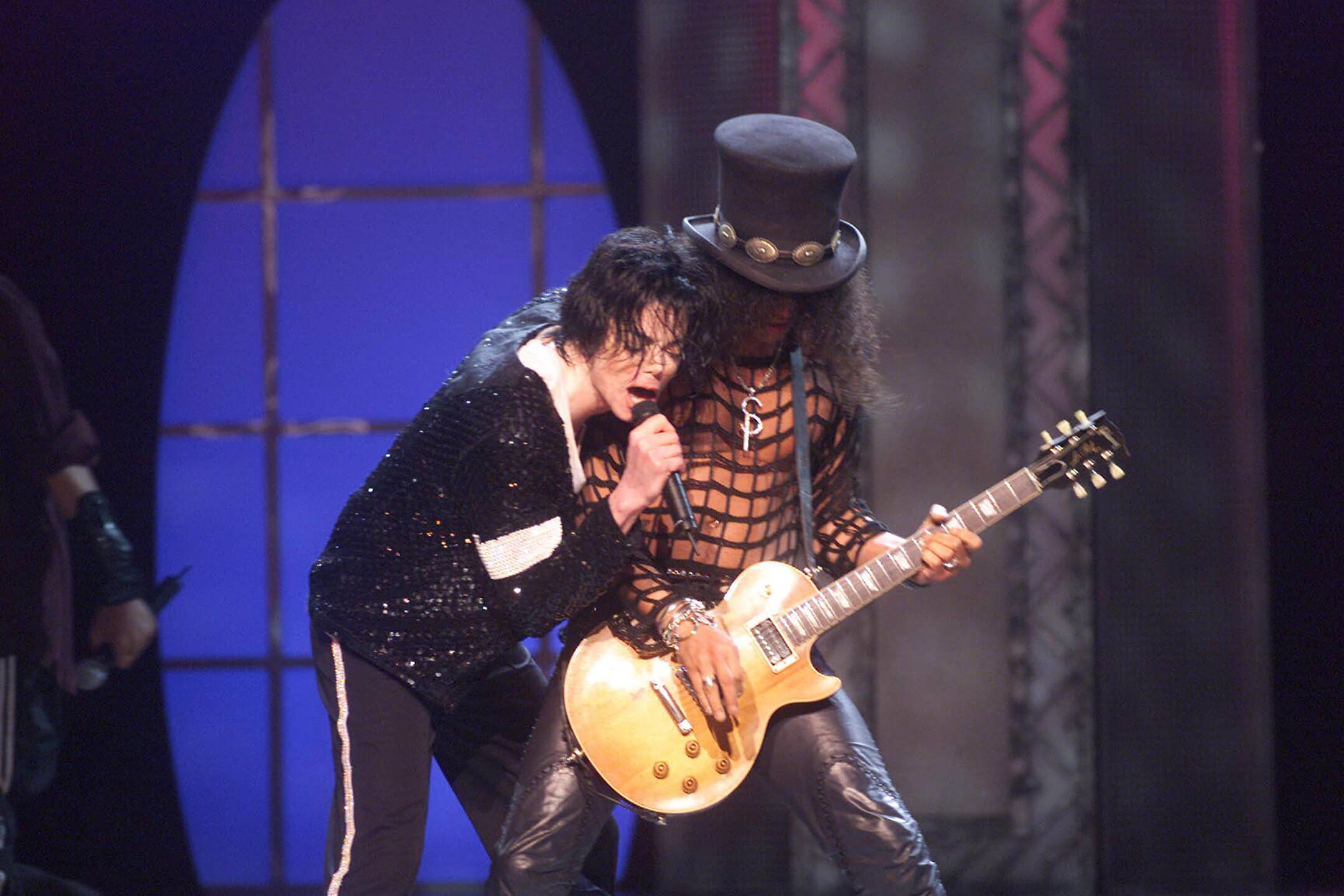
Essential gear
There’s a great rock ‘n’ roll excess photo of Slash from the early 90s, peak GN’R, where he’s sitting grinning in the studio with his collection. It’s mostly Les Pauls, of every hue and type. There must be over 30 LPs pictured… probably more Les Pauls than many Gibson dealers even stock. In 2018, Slash estimated that he owned 220 guitars.
- READ MORE: An oral history of the Gibson Les Paul
Yet the ‘Les Paul’ that Gibson’s most famous endorsee made most famous on Appetite For Destruction wasn’t even a Gibson. It’s a faithful replica of a ’59 by LA luthier Kris Derrig. The guitar was bought for Slash by Guns’ manager in late 1986 specifically for recording AFD, and came already fitted with Seymour Duncan Alnico 2 pickups, not Gibson’s own units. It quickly became Slash’s main studio instrument.
But once the royalties started rolling in, Slash started building an arsenal of authentic Gibson Les Pauls… from signature models to the co-designs of now that see Slash in the role of Brand Ambassador for the sometimes-troubled USA makers.
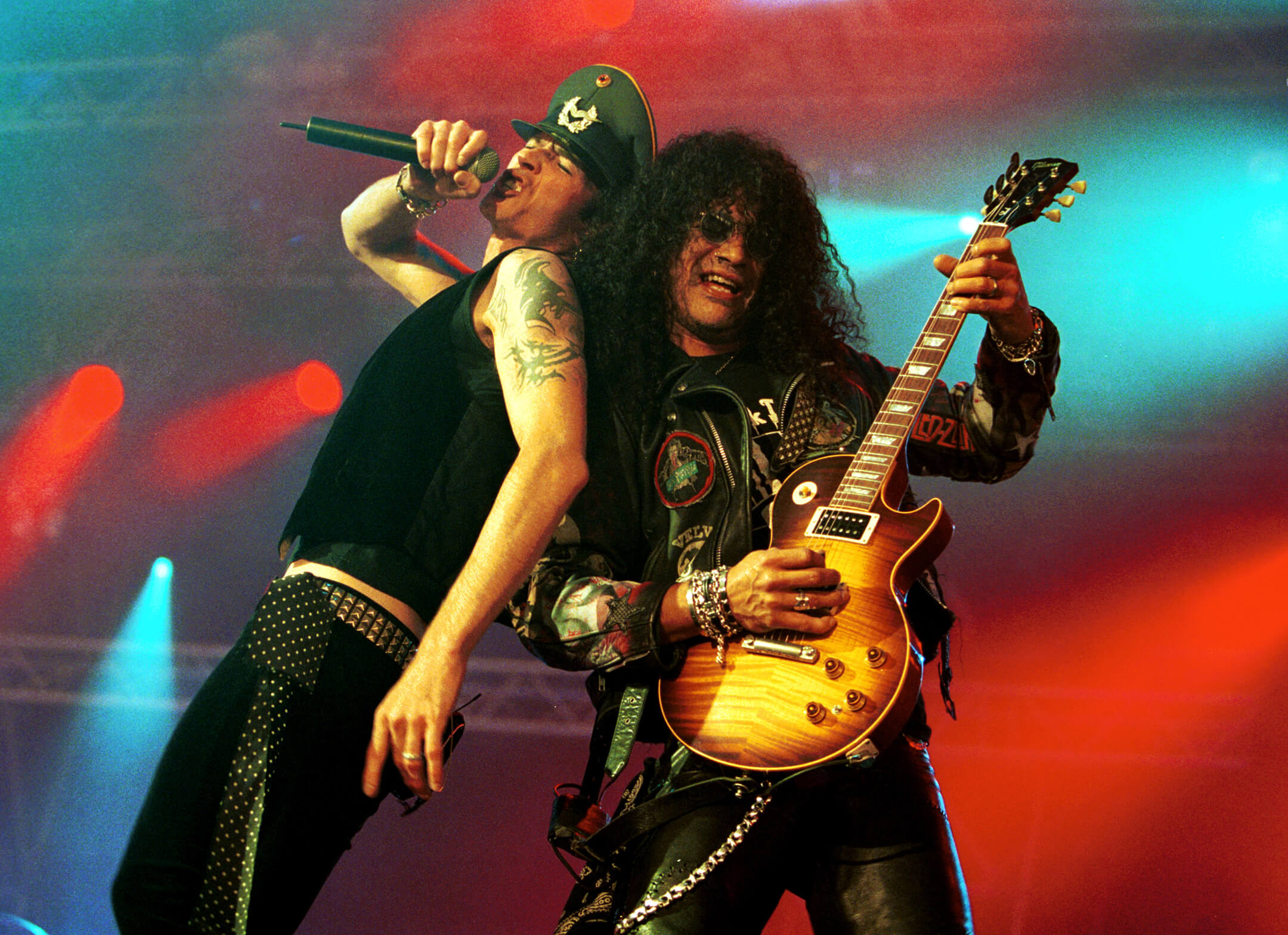
For a long time his main touring LP was a 1987 Standard, which is not overly unique or special. But once he’d caught the bug, there was no going back. There have been around a dozen Slash signature Les Pauls over the years but it started in 1990 with the Custom Shop Slash Les Paul, and went on to include the now-rare Snakepit Standard (1997) and numerous other models including the Slash Les Paul and the Slash AFD, right up to the new Slash collection (including an acoustic!) launched by Gibson earlier this year. There have been some cool colours along the way, on top of the usual sunburst and tobacco bursts, and the occasional Goldtop. Seymour Duncan p’ups remained favoured on all, and in time Slash got his own signature Seymour Duncan Slash pickups. These days, you can even get Seymour Duncan signature Slash pickup covers.
Let’s remind ourselves just of 2010-2020 Slash guitars. The original Slash Signature Vermillion Les Paul (from 2013) you can probably still find for around £2k second-hand, and comes in a stunningly vibrant red finish, headstock decal, and – like most Slash LPs – the 1960 “Slim Taper” neck profile he so loves. Why? Slash has relatively small hands. That said, he’s recently been expressing a lot of love for 1958-style Les Pauls which have a slightly fatter neck.
The Rosso Corsa (Racing Red) Slash Signature was another deeper red finish. Though this was historically interesting too, as it Slash said it was “identical to the old AFD in most respects but it is red. Also, the red colour varies from instrument to instrument so no two are exactly alike.”
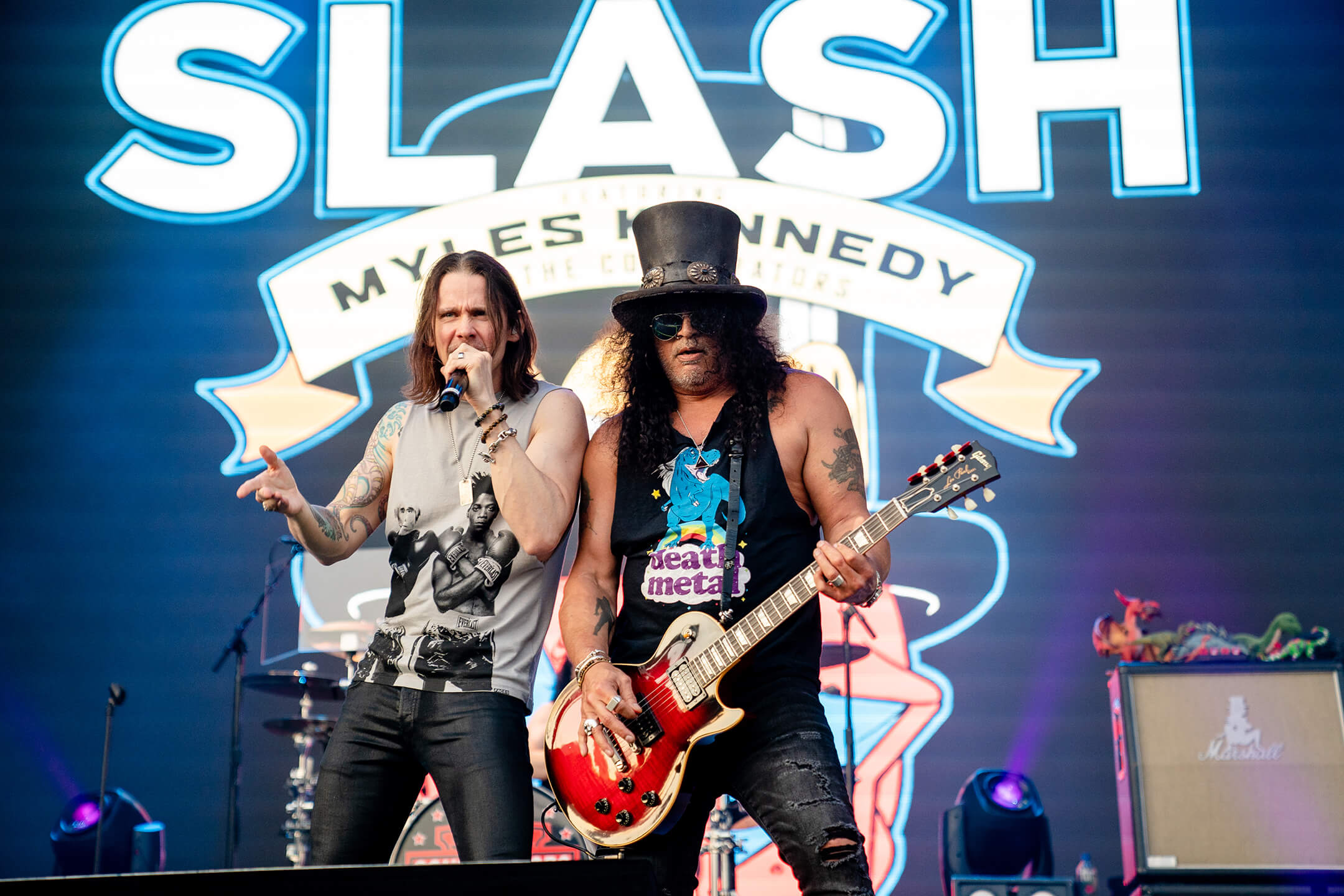
The Snakepit, Vermillion, the Rossa Corsa and the AFD Les Pauls were also made in Epiphone guise, so bargains are to be had. Of course, they’re not identical to the bona fide Gibsons but they are good guitars. Slash seems to keep a good eye on anything bearing his name and all these Epiphones come with pretty glowing reviews. All budgets are covered, right down to the Epiphone Slash AFD Les Paul Special-II Guitar which – although a basic approximation – will only cost you £200.
If you already have an LP, you could always just retrofit Slash’s long-standing sig pickups. The Seymour Duncan Alnico II / Slash Signature humbuckers are based on those units he had in his Kris Derrig-made AFD LP replica, but have extra turns of wire for a richer, throatier tone in the neck position and plenty of crunch and wail in the bridge. Note that Slash himself doesn’t really modify his Les Pauls: if he wants a slightly different flavour, he’ll just buy another one. Or he just gets Gibson to make him what he wants. First world problems, bro!
Oh, and if you want the spec but no Slash scribbling on the guitar, a good starting point is the Gibson Les Paul Standard 60s with its slim-taper neck… although the stock Burst Buckers won’t quite have the unbridled roar of Slash’s own models. If you’re going to retro-fit his signature buckers, you may as well just buy a Slash model!
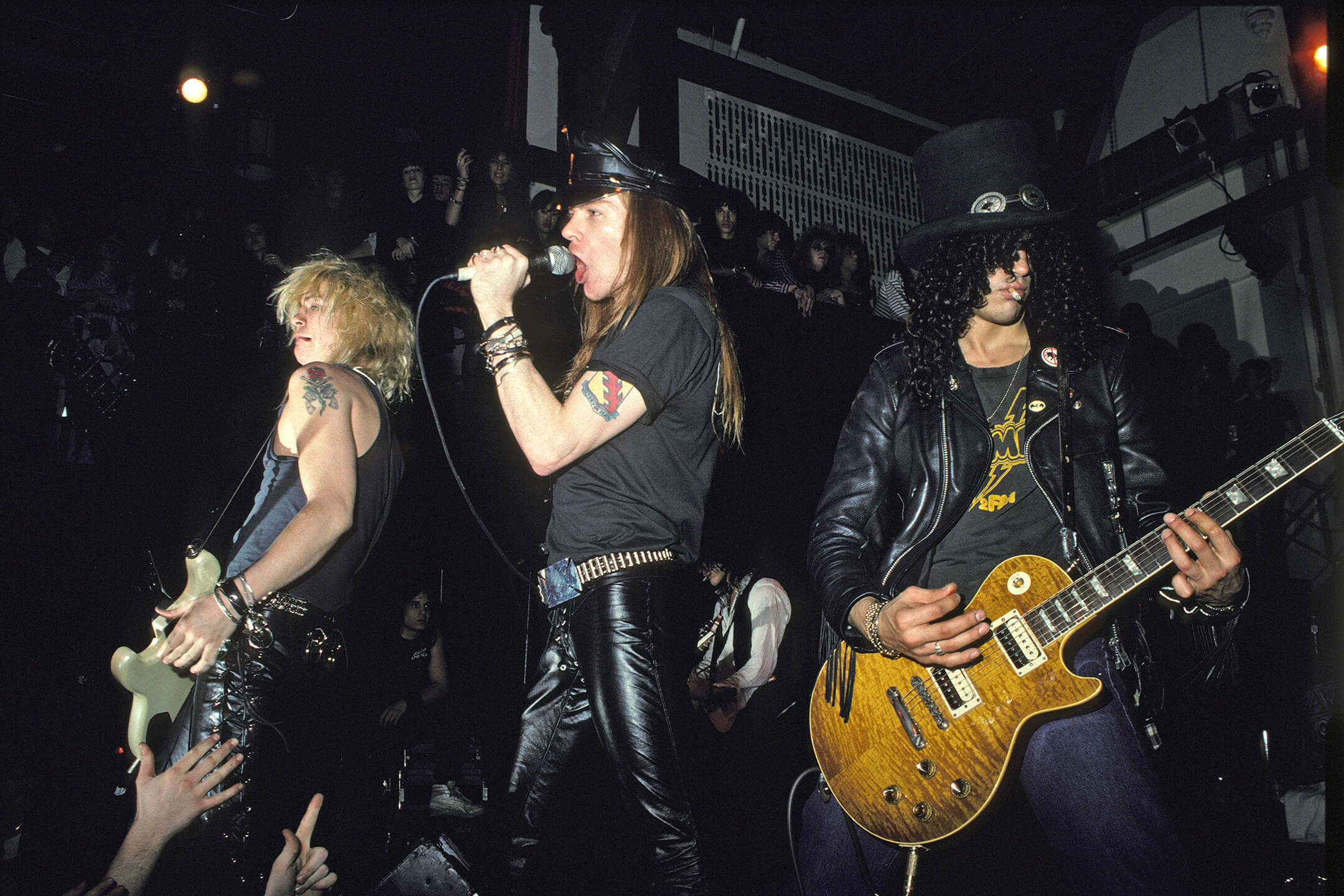
In terms of ‘famous’ buys, one of Slash’s genuine 1959 Les Paul bursts used to belong to his hero Joe Perry. He also reportedly had another replica, of a 1960 LP, the ‘Hunterburst’ that was played by Steve Hunter with Alice Cooper and Lou Reed. Slash only owned it briefly around 1986-87, though: he claims he sold it for drug money.
To linger on the past, there have been other guitars, of course. Hardcore fans will know that in the early days he also had a soft spot for a BC Rich – Mockingbirds and Warlocks, he has/had at least seven BC Riches alone! There was a time when he used a BC Rich on the rare occasion that he wanted to wangle a whammy, but these days he tends towards a Gibson Les Paul Axcess for that.
There were other Gibsons, some Guild acoustics, and metal-necked Travis Beans used specifically for slide. These tended to be used on specific songs – but the way Slash plays, you may be hard-pressed to spot an obvious change in tone. If you want to get super-nerdy, here’s some help on just a few of those extra non-LP axes:
- Gibson Flying V 1959; lead on Live And Let Die and Knockin’ On Heaven’s Door
- Gibson Explorer 1958; lead on Locomotive
- Gibson SG 1960; on My Michelle
- BC Rich Mockingbird; lead on You Could Be Mine, The Truth, The Alien and Headspace
- BC Rich Warlock; on Reckless Life and Mama Kin
- Travis Bean 1000; the slide on Bad Obsession, The Garden, Beggars And Hangers-On, Shine and Rusted Heroes
- Fender Stratocaster 1965; lead on Yesterdays, So Fine, What Do You Want To Be, and Sucker Train Blues
- Fender Telecaster 1956; rhythm on Sucker Train Blues
- Gretsch 6120 Brian Setzer model; rhythm on The Last Fight and Gravedancer
- Guild AJF30 acoustic; Patience, Used To Love Her, You’re Crazy and One In A Million
- Martin D-18; rhythm on Not For Me
- Jose Ramirez Nylon; on Double Talkin’ Jive

Then there’s the live guitars, notably the black Gibson EDS-1275 double-neck used in Guns N’ Roses and Velvet Revolver. This was bought, already refinished and used, in 1990 for the Use Your Illusion tours, but has now been re-crafted as a limited run Slash EDS-1275 signature.
There were also 1993 custom-built Guild Crossroads double-necks (one with electric 6-string/acoustic 12-string config, and two with two 6-string electric/acoustic necks).
Recent years have seen an even closer relationship between Gibson and Slash. In 2017, to mark his appointment as Gibson Global Brand Ambassador, he had his own signature Slash Firebirds launched in Trans White and Trans Black (the latter reminiscent in finish of Joe Perry’s Boneyard Les Paul signature of the 90s). There were just 25 each of the aged versions from Gibson, but Epiphone versions too. There was also a green Anaconda Burst Les Paul.
And there was still a few limited editions for super-rich collectors: the Gibson Slash Signature ‘Brazilian Dream’ Les Paul used rare rosewoods in a £13K beauty. It’s a lot of signature models and an overdose of indulgence, but why not? Slash has probably done more to keep the Gibson Les Paul a hard rocker’s guitar of choice than anyone else since the 1970s. And so to now, with the launch of the Slash Collection.
- READ MORE: Slash tells us about his Gibson Collection, playing with his friends and the new GN’R album
There are Les Pauls – it’s a small difference, but these are not ‘Gibson Les Paul Slash signatures’ but ‘Slash Gibson Les Pauls’! – in November Burst and Appetite Burst, and the Vermillion Burst and Anaconda Burst finishes are also retained. There’s also a top spec Gibson J-45.
These are a distillation of all the collaborative work Slash and Gibson have done over the years – Slash explains here – but honed to the nth degree. They’re not cheap, but they are great. Read Guitar.com’s review.
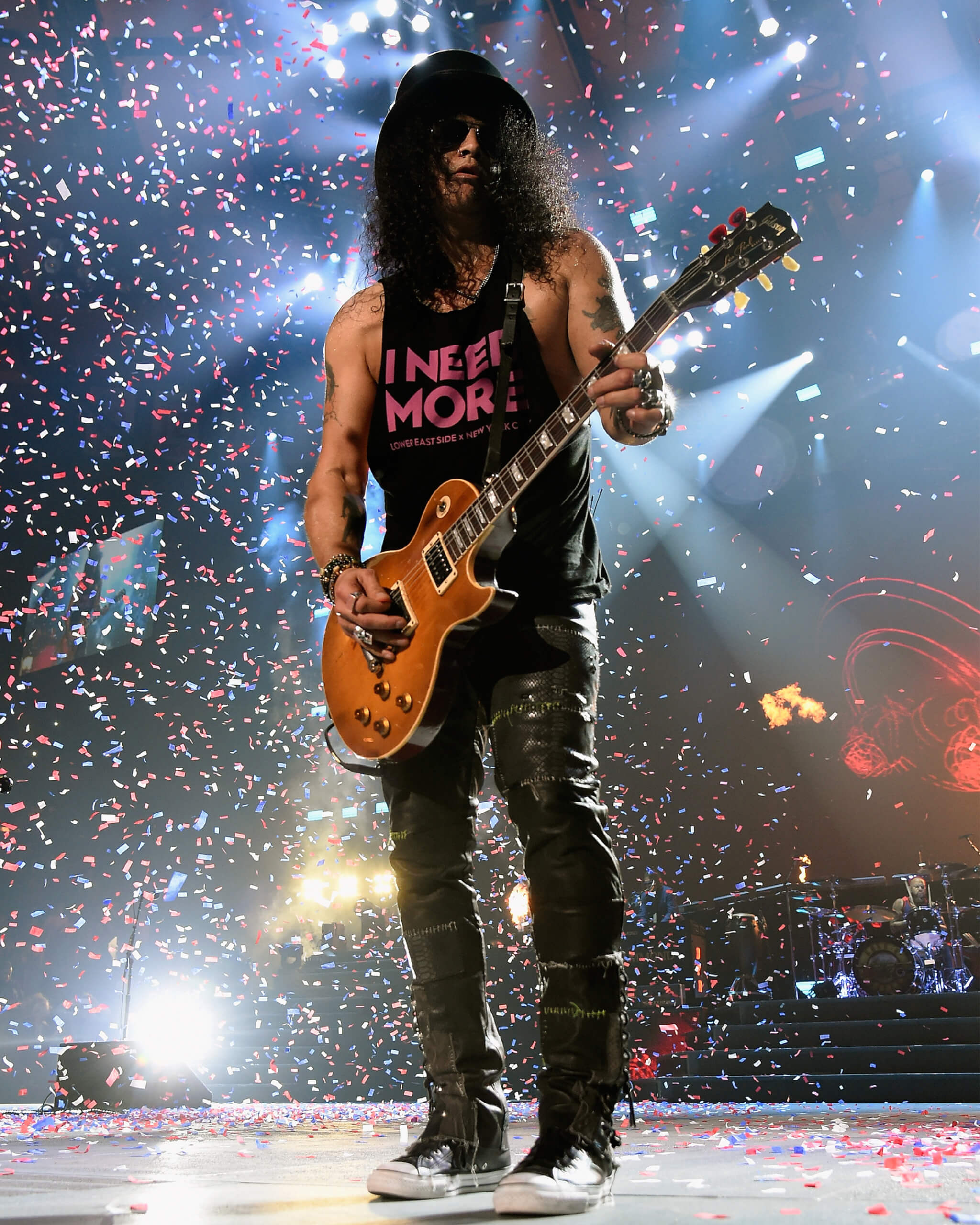
Amps and FX
When it comes to backline, Slash is again a man of simplicity. But that also means l-o-u-d. He’s never notably put his name to a practice combo or digital amp: he simply prefers big and analogue. For the most part that means a signature Marshall. Read here for some early Marshall history.
AFD was recorded on a Marshall 1959T Superlead head, but that was a studio hire. His first collaborative model was the JCM 2555 Signature head. More recently, in an attempt to capture a career of blazing Britrock tones, it’s been the Marshall AFD (Appetite For Destruction) head and 4×12 cabs. Live, he’ll also use an older Marshall JCM800 and he also owns a tweaked Kerry King Signature Marshall 2203KK head for buzzier tones. He’s also using Marshall’s SV20H and the 2525H (based on the fabled Silver Jubilee series). Note: Slash tests an amp to see if he digs it by rotating all dials to 7!
Y’all won’t have the luxury of being able to crank a full Marshall rig on a day-to-day basis, so a good budget option would be a Marshall DSL combo. Universally acclaimed, you can get it in1W to 40W combo specs and it’s classic valve Marshall and ballpark Slash. There was the signature Marshall Slash Signature 5W Combo (now discontinued) but that 1×12 is still around £500+ used if you can find one. If you use PC emulation programs, IK Multimedia still offers its AmpliTube 4 Slash set for around £100. A more in-depth Marshall modelling set comes from the Universal Audio Marshall Legends plug-in. Slash himself is not the kind of guy to use modelling software, decent though these plug-ins are.
Pedals-wise, Slash admits to being a naïf (“I can’t even have them onstage, so my tech switches them”) but his most famous is of course his most-used: a signature Dunlop SW95 Cry Baby Wah, which has its own built-in distortion.
On record, he’s also dialled-in a Dunlop MXR Boost for solos and, occasionally, an MXR Blue Box (octave fuzz) for certain colours. The latter was eventually superseded by his own MXR SF-01 Slash Octave Fuzz.
He’s used a BOSS DD3 Digital Delay, an MXR M134 Stereo Chorus and an MXR M234 Analog Chorus (notably on Paradise City). He’s brand-loyal, too: he also has an MXR EVH-117 Van Halen Flanger and an MXR 104 Distortion+…
But none of these later actual models are really super-crucial to aping the Slash sound. Buy them if you can, but a quality chorus, distortion, octave/fuzz and flanger of any stripe (plus your ears) will help you decide what works. The Wah is probably the key unit of them all. It’s a lot of gear, but it’s pretty old-fashioned and ungimmicky. Just like the man himself.
Will all this get you sounding exactly like Slash? Probably not, but you’ll have a whole heap of fun trying. And for that classic Guns N’Roses twin-guitar rifferama, you and your buddy will need to consider Izzy Stradlin’s own sound as well. Give us a break…

Essential listening
For the discs that made his name, GN’R’s Appetite For Destruction and Use Your Illusion albums are compulsory, of course. GN’R Lies perhaps less so, the covers LP The Spaghetti Incident a fun but a bit of a throwaway. More recently, 2014’s World On Fire with Myles Kennedy and the Conspirators packs a lot of riffage, and the Live At The Roxy DVD (2014) rattles through his whole career’s highlights, sung by Kennedy. The most recent Living The Dream (2018) saw Frank Sidoris join on rhythm guitar to help Slash out (who by this point was also writing for the new Guns N’Roses project).
Then there’s the numerous guest spots, some of which were always on point (Lenny Kravitz), some of which always baffling (Michael Jackson, the Bee Gees).
And that new Guns music? After a few years of enormous gigs playing the old classics, everyone is still waiting…
Anyway, Guitar.com’s hand-picked playlist also includes Slash’s own seven favourite tracks of his (as told to The Guardian). Wonder if you can guess which ones…?
Playing style
Above all, Slash is a highly melodic player for his genre. He’s not really a shredder in the mould of some “metal” guitarists. He claims to know no theory and can’t read music, but – even if it’s subliminal, or by accident – he knows his scales. The blues scale is at the heart of most of his soloing and top-line melodies, but musicologists who have analysed his playing reveal he (even if unwittingly) uses major scales, minor relative scales, minor harmonic scales and more. For all we know, Slash doesn’t even think in these terms.
In terms of style, he employs a lot of powerful vibrato and a strong arsenal of speed, from 16th note flurries to drawn-out bends. His tone is thick, but mostly amp-driven… and it’s not always fuzzy, but fatly distorted. So careful with those pedals. And like him, start with your amp at 7 not always cranked flat out.

He actually says of Myles Kennedy, his singer/fellow guitarist in his own band, “Myles teaches me stuff. Technically he’s much more proficient than I am. He knows way more about all that stuff. There’s been a few times where he’s shown me licks, runs, arpeggios or scales and I’m like, ’What was that?” Simply, Slash’s style “happens” when you base your soloing runs on the notes of the underlying chords, even as these progress bar-to-bar. It’s all about melody.
He’s very self-effacing when asked about his own style, preferring to discuss his own heroes. One week, he’ll say his favorite player is Joe Perry. The next, it’s Rory Gallagher. He’ll name-check David Gilmour, Brad Whitford, Eddie Van Halen, Paul Kossoff, Page, Clapton, Mick Ronson, The Cars’ Elliot Easton, Billy F Gibbons, “the guy” who played the solo on the Manfred Mann’s Earth Band’s cover of Springsteen’s Blinded By The Light (Dave Flett, should you also need to know)… the guy knows his classic rock. Nothing unusual in this, but this melange of influences never shows its hand too obviously in his own playing. He’s learned the hardest trick of all: he sounds like Slash.
